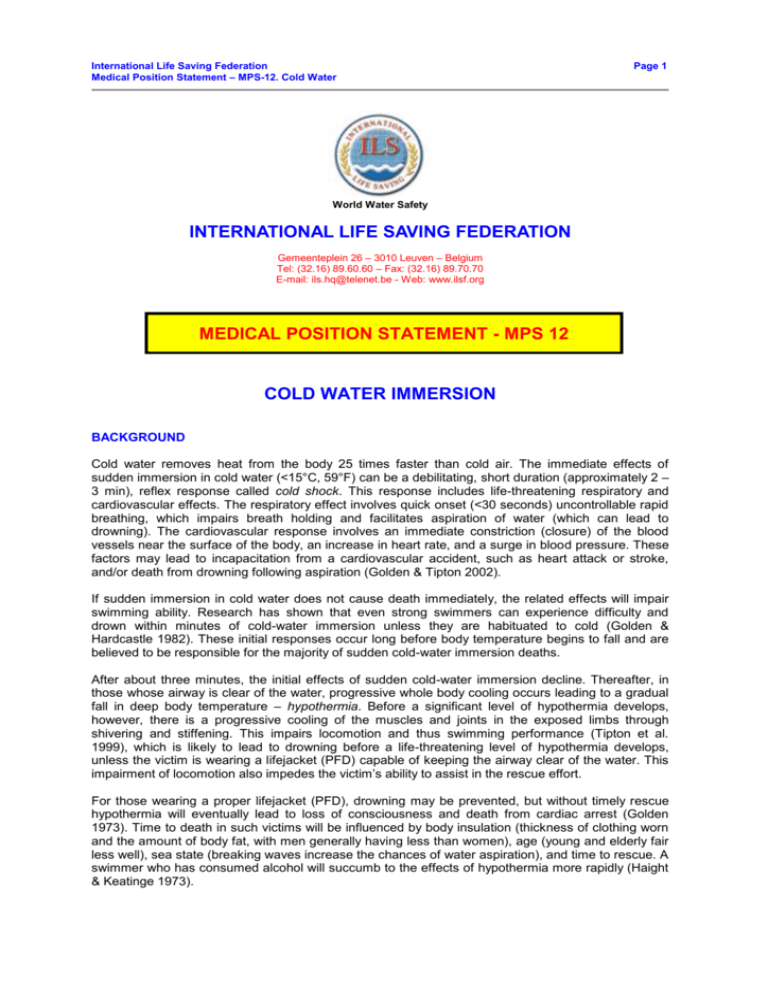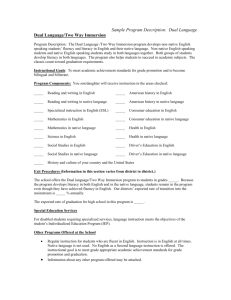MPS-12 - Cold water immersion - International Life Saving Federation
advertisement

International Life Saving Federation Medical Position Statement – MPS-12. Cold Water Page 1 World Water Safety INTERNATIONAL LIFE SAVING FEDERATION Gemeenteplein 26 – 3010 Leuven – Belgium Tel: (32.16) 89.60.60 – Fax: (32.16) 89.70.70 E-mail: ils.hq@telenet.be - Web: www.ilsf.org MEDICAL POSITION STATEMENT - MPS 12 COLD WATER IMMERSION BACKGROUND Cold water removes heat from the body 25 times faster than cold air. The immediate effects of sudden immersion in cold water (<15°C, 59°F) can be a debilitating, short duration (approximately 2 – 3 min), reflex response called cold shock. This response includes life-threatening respiratory and cardiovascular effects. The respiratory effect involves quick onset (<30 seconds) uncontrollable rapid breathing, which impairs breath holding and facilitates aspiration of water (which can lead to drowning). The cardiovascular response involves an immediate constriction (closure) of the blood vessels near the surface of the body, an increase in heart rate, and a surge in blood pressure. These factors may lead to incapacitation from a cardiovascular accident, such as heart attack or stroke, and/or death from drowning following aspiration (Golden & Tipton 2002). If sudden immersion in cold water does not cause death immediately, the related effects will impair swimming ability. Research has shown that even strong swimmers can experience difficulty and drown within minutes of cold-water immersion unless they are habituated to cold (Golden & Hardcastle 1982). These initial responses occur long before body temperature begins to fall and are believed to be responsible for the majority of sudden cold-water immersion deaths. After about three minutes, the initial effects of sudden cold-water immersion decline. Thereafter, in those whose airway is clear of the water, progressive whole body cooling occurs leading to a gradual fall in deep body temperature – hypothermia. Before a significant level of hypothermia develops, however, there is a progressive cooling of the muscles and joints in the exposed limbs through shivering and stiffening. This impairs locomotion and thus swimming performance (Tipton et al. 1999), which is likely to lead to drowning before a life-threatening level of hypothermia develops, unless the victim is wearing a lifejacket (PFD) capable of keeping the airway clear of the water. This impairment of locomotion also impedes the victim’s ability to assist in the rescue effort. For those wearing a proper lifejacket (PFD), drowning may be prevented, but without timely rescue hypothermia will eventually lead to loss of consciousness and death from cardiac arrest (Golden 1973). Time to death in such victims will be influenced by body insulation (thickness of clothing worn and the amount of body fat, with men generally having less than women), age (young and elderly fair less well), sea state (breaking waves increase the chances of water aspiration), and time to rescue. A swimmer who has consumed alcohol will succumb to the effects of hypothermia more rapidly (Haight & Keatinge 1973). International Life Saving Federation Medical Position Statement – MPS-12. Cold Water Page 2 One very rare complication of contact with cold water is cold urticaria. This condition is an allergy-like reaction to contact with cold water, as well as other sources of cold (Bentley 1993). Within minutes, the skin may become itchy, red, and swollen. Fainting, very low blood pressure, and shock-like symptoms can present. STATEMENT 1. Prevention is the best cure. Do not attempt to swim in cold water unless habituated to it or wearing suitable protective garments, such as a wetsuit or survival suit. If at risk of immersion take precautions against becoming immersed, such as by use of a safety line. If in a boat, wear suitable clothing and an approved lifejacket with sufficient buoyancy to keep your airway clear of the water even when unconscious. Lifejackets fitted with splash guards are recommended. If immersed, reach for any flotation available, though maintaining your grip may be difficult due to lack of coordination and weakness caused by the cold. 2. Various methods of body positioning, previously recommended to help reduce heat-loss in the cold-water immersion victim, are now believed to have an insignificant benefit. However, if two or more persons find themselves in distress in cold water, they should attempt to remain in close proximity for moral support and to aid in rescue. 3. All immersion victims should be quickly rescued. Those victims who have been in cold water for a considerable time, and whose airways are not being threatened by wave splash, should be rescued in a near horizontal attitude, if possible, to prevent a potentially adverse fall in blood pressure (Golden et al. 1991). Those whose airways are threatened should be rescued by the quickest method regardless of body attitude. 4. Victims who are not in need of resuscitation should have wet clothing removed and replaced with dry clothing, if available. They should then be enclosed in a sleeping bag, or otherwise insulated in blankets or the like, making sure that their airways are clear and supported. Conscious shivering survivors will generally rewarm themselves reasonably quickly with such treatment, but the process can be accelerated by immersion in a bath of warm water. When recovered, they should be removed from the bath before they start to sweat, usually as their pulse begins to increase. 5. In case of unconsciousness or apparent cardiac arrest, the airway should be cleared and appropriate procedures should be employed according to CPR protocols. It may be difficult to assess whether the unconscious victim of hypothermia has a heartbeat, because the heartbeat may be extremely slow and a pulse hard to assess. Check carefully for a carotid pulse for at least 60 seconds to ensure that cardiac compressions are not used unless the heart has stopped. Since near-drowning victims are typically starved of oxygen, pay particular attention to ventilating the victim (mouth-to-mouth or mouth-to-nose) within CPR protocols. Arrange rapid transfer to hospital and use oxygen, if available. 6. In those who are apparently dead, avoid a hasty diagnosis. The maxim “no one is dead until they are warm and dead” is appropriate provided you are not too remote from medical support. Follow resuscitation protocols and arrange rapid transport to hospital. People, especially small children, who have been submerged for up to an hour in ice-cold water have been successfully resuscitated in hospital (Bolte et al. 1988). 7. Persons who have inhaled water or who have experienced serious hypothermia, even if successfully revived, should always be sent to hospital to be checked for pulmonary complications (Modell 1971). 8. In cases of apparent cold water urticaria, removal from the source of cold is essential. Treatment is similar to that for any allergic reaction, with priority being given to maintaining breathing and circulation. Antihistamines may be effective (Bentley 1993; Mathelier-Fusade 1998). International Life Saving Federation Medical Position Statement – MPS-12. Cold Water Page 3 REFERENCES Bentley II, Burton (1993). Cold-induced urticaria and angioedema: diagnosis and management. American Journal of Emergency Medicine, 11, 1: 43 – 46. Bolte, R.G., Black, B.G., Bowers, R.S., Kent-Thorne, J., & Correli, H.M. (1988). The use of extracorporeal rewarming in a child submerged for 66 minutes. Journal of the American Medical Association, 260, 377-379. Golden, F.St.C. (1973). Recognition and treatment of immersion hypothermia. Proceedings of the Royal Society of Medicine, 66, 1058-61. Golden, F.St.C. & Hardcastle, P.T. (1982). Swimming failure in cold water. Journal of Physiology, 330, 60-1P. Golden, F.St.C., Hervey, G.R. & Tipton, M.J. (1991). Circum-rescue collapse: collapse, sometimes fatal, associated with rescue of immersion victims. Journal of the Royal Naval Medical Service, 77, 139-49. Golden, F. & Tipton, M. (2002). Essentials of Sea Survival. Champaign, IL: Human Kinetics. Haight, J.S.J. & Keatinge, W.R. (1973). Failure of thermoregulation in the cold during hypoglycaemia induced by exercise and alcohol. Journal of Physiology, 229, 87-97. Mathelier-Fusade & Pascale (1998). Clinical predictive factors of severity in cold urticaria (correspondence). Archives of Dermatology, 134, 106 – 107. Modell, J.H. (1971). Pathophysiology and Treatment of Drowning and Near-drowning. Springfield, Ill: CC Thomas. Tipton, M.J., Eglin, C., Gennser, M., & Golden, F. (1999). Immersion deaths and deterioration in swimming performance in cold water. Lancet, 354, 626-629. Approved by the ILS Board of Directors: 01/05/2003.







